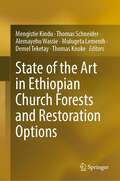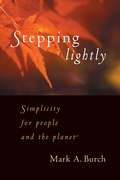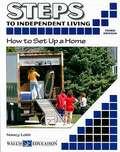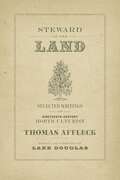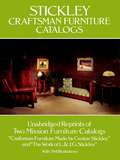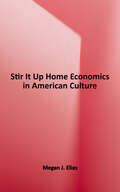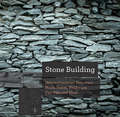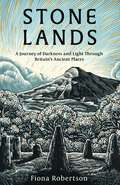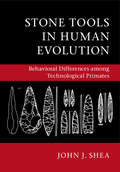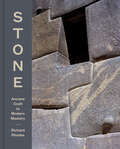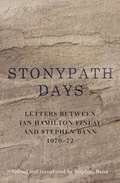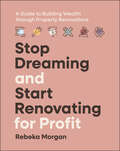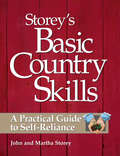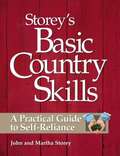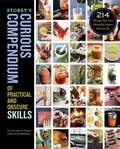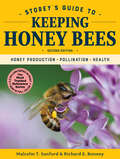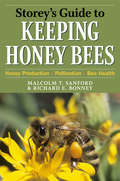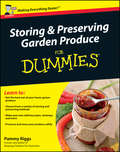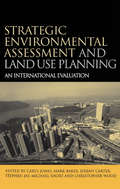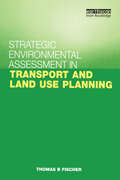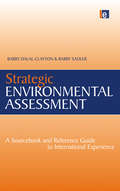- Table View
- List View
Starting Your Career as an Interior Designer (Starting Your Career Ser.)
by Robert K. Hale Thomas L. WilliamsStarting Your Career as an Interior Designer contains all the necessary tools and strategies to successfully launch and grow a professional design business in the competitive world of interior design. Drawing on the authors' extensive experience, this book includes case studies, and personal anecdotes that help teach you how to: Choose a design field Obtain and keep clients Garner referrals Market and position your business Bid competitively on projects Manage sales Organize a budget Manage start-up costs and cash flow Promote your business Branch out into product and architectural design Design within a retail environment Set pricing guidelines Sell to your target demographic Set up your officeReaders will find a history of the business side of interior design as well as various career tracks available to today’s budding entrepreneur. This updated second edition also examines the current state of the interior design industry, and what's in store for the future of firms. Any early career interior designer or student looking for practical advice on the ins and outs of running a design firm will need this one-stop guide.Allworth Press, an imprint of Skyhorse Publishing, publishes a broad range of books on the visual and performing arts, with emphasis on the business of art. Our titles cover subjects such as graphic design, theater, branding, fine art, photography, interior design, writing, acting, film, how to start careers, business and legal forms, business practices, and more. While we don't aspire to publish a New York Times bestseller or a national bestseller, we are deeply committed to quality books that help creative professionals succeed and thrive. We often publish in areas overlooked by other publishers and welcome the author whose expertise can help our audience of readers.
State of the Art in Ethiopian Church Forests and Restoration Options
by Thomas Schneider Demel Teketay Mengistie Kindu Alemayehu Wassie Mulugeta Lemenih Thomas KnokeThis book, with contributions from leading academics - and including reviews and case studies from Ethiopian Church forests - provides a valuable reference for advanced students and researchers interested in forest and other natural resource management, ecology and ecosystem services as well as restoration options. The book addresses various aspects including a general overview of Ethiopian church forests, the present role and future challenges of church forests. It also discusses their structure and diversity in the context of sustainability and discusses restoration options for surrounding landscapes, under consideration of the circumstances of the land and the needs of surrounding communities. The intended readership includes natural resource professionals in general as well as forestry professionals in particular (practitioners, policymakers, educators and researchers). The book will provide the reader with a good foundation for understanding Ethiopian forest resources and restoration options of degraded landscape.
Stepping Lightly
by Mark A. BurchWhile the voluntary simplicity movement has grown by leaps and bounds in recent years, it is still often stereotyped as being mainly concerned with a thrifty lifestyle. But simple living has much deeper implications than just cleaning closets or selling off a second car. In Stepping Lightly, Mark Burch considers the deeper rewards of voluntary simplicity for individuals, and how the practice of simple living can be an essential part of the solution to our social and environmental problems. Thoughtful and eloquent, this book will appeal to a wide range of readers interested in committing themselves to stepping lightly into a more sustainable future.
Steps To Independent Living: How To Set Up A Home
by Nancy LobbCompletely updated, part of the best-selling series that shows students how to take care of themselves and face the challenges of everyday living. Explains essential tasks and responsibilities at a manageable reading level, with demonstrations, activities, illustrations, self-tests and comprehension checks throughout the text. How to Set Up a Home explains how to find an affordable place to live; how to choose a suitable roommate; and how to understand a lease, deal with utilities, and furnish an apartment .
Steward of the Land: Selected Writings of Nineteenth-Century Horticulturist Thomas Affleck (The Hill Collection: Holdings of the LSU Libraries)
by Lake Douglas Thomas AffleckIn the first collection of published writings of Thomas Affleck (1812--1868), Lake Douglas re-establishes the reputation of a tireless agricultural reformer, entrepreneur, and horticulturist. Affleck's wide range of interests -- animal husbandry, agriculture, scientific farming, ornamental horticulture, insects, and hydrology, among others -- should afford him a celebrated status in several disciplines; yet until now his immense contributions remained largely unheralded. Steward of the Land remedies this oversight with a broad, annotated selection of Affleck's works, rightfully placing him alongside his better-known contemporaries Andrew Jackson Downing and Frederick Law Olmsted.After immigrating to the United States from Scotland in 1832, Affleck witnessed the burgeoning American expansion and its major advances in agriculture and technology. He worked as a journalist for the influential Western Farmer and Gardener, covering Ohio, Kentucky, and the Mississippi River Valley. Affleck moved to Mississippi in 1842 to manage his new wife's failing plantation; there, he created one of the first commercial nurseries of the South while writing prolifically on numerous agrarian topics for regional periodicals and newspapers. From 1845 to 1865 he edited Affleck's Southern Rural Almanac and Plantation and Garden Calendar, published in New Orleans. Following a postwar move to Brenham, Texas, he published letters and essays about rebuilding that state's livestock herds and rejuvenating its agricultural labor forces.Steward of the Land includes excerpts from dozens of Affleck's articles on subjects ranging from bee keeping to gardening to orchard tending. This valuable single-volume resource reveals Affleck's astonishing breadth of horticultural knowledge and entrepreneurial sagacity, and his role in educating mid-nineteenth-century readers about agricultural products and practices, plant usage, and environmental stewardship. Never before collected or contextualized, Affleck's writings provide a firsthand account of the advancement of agricultural techniques and practices that created a new environmental awareness in America.
Stickley Craftsman Furniture Catalogs
by Gustav Stickley L. Stickley594 illustrations, including 277 photos, of authentic, prized, Craftsman furniture as shown in two catalogs -- circa 1910 -- by foremost manufacturers. Numerous settles, rockers, armchairs, bookcases, plus many other kinds of pieces. Captions.
Stir It Up: Home Economics in American Culture
by Megan J. EliasFor Americans who came of age in the mid-twentieth century, home economics conjures memories of burnt toast and sewing disasters. But as historian Megan Elias shows in Stir It Up, home economics began as an idealistic reform movement in higher education in the early 1900s. Leaders of this movement sought to discover and disseminate the best methods for performing domestic work while creating new professional options for women that were based on elements of home life. Home and family were treated as subjects for scientific analysis; students wore lab coats while baking bread and performed rigorous tests on the palatability of their work. The Federal Bureau of Home Economics supplied a grateful audience with informational bulletins as Americans seemed to accept the idea that home could be a site for social change. <p><p>A major shift occurred in the 1950s, when new ideas about women's roles seemed to divert home economics into more traditional channels, and "home ec" became identified with the era's conformist culture. Even as home economists were redefining family dynamics and influencing government policies, such as school lunch programs, their field was becoming an object of scorn, especially to the feminists of the 1960s. Stir It Up explains what the successes and failures of home economists can tell us about American culture. The book concludes with an examination of contemporary attitudes toward domesticity, putting the phenomena of Martha Stewart, Rachael Ray, Ty Pennington, and the "Mommy Wars" into historical context.
Stockholm: The Making of a Metropolis (Planning, History and Environment Series)
by Thomas HallThis is the first history of Stockholm’s development from the city’s unique seventeenth-century redevelopment and extension to the postmodern, postindustrial trends of today. While the city’s planners borrowed the ideas from abroad at certain periods, they provided the lead for the rest of the world at others. For much of the mid-twentieth century Stockholm was the model for Europe and elsewhere. Written by an acknowledged authority on the city and Swedish architecture and planning generally, with a wide range of illustrations, this book provides a much needed explanation of one of Europe’s great cities.
Stone Building: How To Make New England Style Walls And Other Structures The Old Way (Countryman Know How #0)
by Kevin GardnerA practical guide to simple stone building projects for your yard Nothing matches the look and feel of stone structures in and around your home. Yet most people are intimidated by the very thought of masonry, despite the obvious rewards. In Stone Building, Kevin Gardner distills his decades of experience building and maintaining iconic New England–style stone walls into this concise, informative guide. Gardner offers step-by-step instructions for building everything from flagstone walkways to classic patios and ornate fire pits. He also offers time-tested tips to help care for your stone, as well as repair and restoration advice for existing structures.
Stone Lands: A Journey of Darkness and Light Through Britain’s Ancient Places
by Fiona Robertson'Superb' Telegraph'There's a real sense of peace and magic in this beautiful book' Daisy Buchanan'Utterly endearing' Dr James Canton'A fantastic book for weird walkers and megalith-obsessives alike' Weird WalkJourneying across Britain, from West Penwith and Avebury to the Lake District and Orkney, Stone Lands uncovers the magic and rich history of our incredible prehistoric standing stones. It conveys the delight that lies in tracking them down, as well as the solace these ancient places offer in times of darkness.A few months after discovering that her beloved husband, Stephen, had incurable cancer, Fiona Robertson began to write this book. A long-time megalith enthusiast, she found the ancient stones resonated with her more profoundly than ever as she faced the prospect of losing him. Set upright thousands of years ago, the megaliths are symbols of endurance and survival, standing in contrast to our ephemeral human lives. Infused with folklore, legend and mystery, they enchant the landscape and bring magic to our modern world. This enthralling memoir is woven delicately around great grief but is ultimately about embracing life, joy and ancient wonder - a luminous reminder of what it means to exist on this earth.Stone Lands is beautifully illustrated inside with stunning black and white line drawings by the illustrator and printmaker Philip Harris. Find out more about his work: www.philipharrisillustration.com'A reminder that the ancient stones can be sources of reassurance and solidity, even in our times of greatest upheaval and loss' Angeline Morrison
Stone Lands: A Journey of Darkness and Light Through Britain’s Ancient Places
by Fiona Robertson'Superb' Telegraph'There's a real sense of peace and magic in this beautiful book' Daisy Buchanan'Utterly endearing' Dr James Canton'A fantastic book for weird walkers and megalith-obsessives alike' Weird WalkJourneying across Britain, from West Penwith and Avebury to the Lake District and Orkney, Stone Lands uncovers the magic and rich history of our incredible prehistoric standing stones. It conveys the delight that lies in tracking them down, as well as the solace these ancient places offer in times of darkness.A few months after discovering that her beloved husband, Stephen, had incurable cancer, Fiona Robertson began to write this book. A long-time megalith enthusiast, she found the ancient stones resonated with her more profoundly than ever as she faced the prospect of losing him. Set upright thousands of years ago, the megaliths are symbols of endurance and survival, standing in contrast to our ephemeral human lives. Infused with folklore, legend and mystery, they enchant the landscape and bring magic to our modern world. This enthralling memoir is woven delicately around great grief but is ultimately about embracing life, joy and ancient wonder - a luminous reminder of what it means to exist on this earth.Stone Lands is beautifully illustrated inside with stunning black and white line drawings by the illustrator and printmaker Philip Harris. Find out more about his work: www.philipharrisillustration.com'A reminder that the ancient stones can be sources of reassurance and solidity, even in our times of greatest upheaval and loss' Angeline Morrison
Stone Tools in Human Evolution
by John J. SheaIn Stone Tools in Human Evolution, John J. Shea argues that over the last three million years hominins' technological strategies shifted from occasional tool use, much like that seen among living non-human primates, to a uniquely human pattern of obligatory tool use. Examining how the lithic archaeological record changed over the course of human evolution, he compares tool use by living humans and non-human primates and predicts how the archaeological stone tool evidence should have changed as distinctively human behaviors evolved. Those behaviors include using cutting tools, logistical mobility (carrying things), language and symbolic artifacts, geographic dispersal and diaspora, and residential sedentism (living in the same place for prolonged periods). Shea then tests those predictions by analyzing the archaeological lithic record from 6,500 years ago to 3. 5 million years ago.
Stone: Ancient Craft to Modern Mastery
by Richard RhodesIn this perceptive and illustrative look at the expressive and practical use of stone throughout history, Richard Rhodes unlocks the underlying principles of this ancient material—and explains the closely guarded “Sacred Rules” of the Freemasons guild for the first time ever.The relationship between mankind and stone is elemental and deeply ingrained in us all. Stone, after all, has been the primary building material for more than five thousand years of human history, and it continues to record our triumphs and failures. In this searching history, Rhodes—a sculptor, stonemason, and scholar of stonework—explores how stone is best used today and throughout history. Stone presents the closely kept “Sacred Rules” developed over centuries by the medieval Freemason guild, previously available only to the initiated. Here, the rules are explained through historical examples and photographs. In these times of rapid development and expansive urbanization, Rhodes implores us to explore the essential qualities of stone that emerge from the Sacred Rules, not only to rediscover the ancient and traditional knowledge that governed its use for so long but also to find a roadmap for how future generations might thoughtfully recapture the power this material offers.MOST RENOWNED STONEMASON IN THE U.S.: Richard Rhodes apprenticed as a stonemason in Siena, Italy, after graduate studies at the London Academy of Music and Dramatic Art. As the first non-Italian admitted into Siena’s ancient masonic guild in 726 years, he is known throughout the sculpture and stone community as the “last apprentice.” HISTORICAL EDUCATION: A nationally acclaimed lecturer and educator, Rhodes has shared his deep knowledge of the history of stone and stonemasonry through convention addresses to the American Institute of Architects and the Association of Professional Landscape Designers, a five-lecture educational series to the Institute of Classical Architecture in both New York and San Francisco, and lectures to the Building Stone Institute and many public and private universities. His work has been featured in Architectural Digest, New York Times, Architectural Record, MSNBC, The Globe and Mail, Greenwich Post, Seattle Times, and The Globe and Mail, among many others. EXPERT CONTRIBUTOR: The book includes a foreword by Paul Goldberger, a contributing editor at Vanity Fair and previous architecture critic for both the New Yorker and the New York Times, where he was awarded the Pulitzer Prize. He is the author of many books, including Why Architecture Matters.
Stonypath Days: Letters between Ian Hamilton Finlay and Stephen Bann 1970-72
by Stephen Bann Ian Hamilton FinlayThese letters to (and from) Finlay's friend, the English poet and scholar, Stephen Bann, centre on the initial development of the garden at Stonypath, near Edinburgh, later to become the world renowned 'Little Sparta'. They cover Finlay's turn away from poetry towards sculpture and garden design, and the thinking behind, and consequences of, this development.
Stop Dreaming and Start Renovating for Profit: A Guide to Building Wealth through Property Renovations
by Rebeka MorganTurn your passion for renovating and home design into profit Do you love the idea of renovating and flipping houses, but you’re scared to take the plunge? Stop Dreaming and Start Renovating for Profit is an inspiring, practical how-to guide for creating financial independence by renovating and reselling residential properties. Registered builder and successful developer Rebeka Morgan has helped thousands of women buy, renovate and sell properties for profit. In this book, she shares her tried-and-tested advice for harnessing your unique strengths to strategically improve a property’s value — and build your wealth quickly. You’ll grow your skills as a planner, decision maker and developer, learning how to be creative and find the gains that add up to thousands of dollars in profit. And you’ll discover how renovating can be a flexible, profitable business that fits into your busy life. Whether you’re caring for your family, rethinking your career or simply looking to boost your income, this book will empower you to take action and grow your earnings. Inside, you’ll find: Practical tools and case studies to help you see the big picture, find your vision and seize the courage to get started Strategies for analysing feasibility and designing profitable projects Hands-on, step-by-step guidance for managing the design and build process Advice that will help you avoid time-consuming and costly mistakes Tips for marketing and selling your property once the renovations are done Renovating property is not a guaranteed shortcut to quick profits. Getting a return on your investment is about seeing a home’s potential and then taking smart steps to realise that potential. Whether you’re just getting started or you’re looking to build a business flipping homes, Stop Dreaming and Start Renovating for Profit is a can’t-miss resource.
Store It!
by Mervyn KaufmanSTORE IT is the comprehensive guide to making, finding and organizing space in your home from the entryway to the attic.
Storey's Basic Country Skills: A Practical Guide to Self-Reliance
by John Storey Martha StoreyWhether you live on a small suburban lot or have a many acres in the country, this inspiring collection will empower you to increase your self-sufficiently and embrace a more independent lifestyle. A variety of authors share their specialized knowledge and provide practical instructions for basic country skills like preserving vegetables, developing water systems, keeping farm animals, and renovating barns. From sharpening an axe to baking your own bread, you&’ll be amazed at the many ways learning traditional skills can enrich your life.
Storey's Basic Country Skills: A Practical Guide to Self-reliance
by John Storey Martha Storey Storey Books StaffWhether you live on a small suburban lot or have a many acres in the country, this inspiring collection will empower you to increase your self-sufficiently and embrace a more independent lifestyle. A variety of authors share their specialized knowledge and provide practical instructions for basic country skills like preserving vegetables, developing water systems, keeping farm animals, and renovating barns. From sharpening an axe to baking your own bread, you'll be amazed at the many ways learning traditional skills can enrich your life.
Storey's Curious Compendium of Practical and Obscure Skills: 214 Things You Can Actually Learn How to Do
by How-To Experts at Storey PublishingHave you ever wondered how to capture a swarm of bees? Predict the weather by the clouds? And just how do you darn a pair of socks, anyway? Anyone curious about the myriad ways people have taught themselves to make, grow, and build things will find everything they&’ve ever wondered about in this colorful, inviting volume. With dozens of useful and intriguing visual tutorials selected from Storey&’s extensive library of how-to books, you can learn how to carve a turkey, create a butterfly garden, set up a dog agility course, keep a nature sketchbook, navigate by the stars, and more. Whether you plan to &“do it yourself&” or just love reading about how things are done, this rich compendium will educate, fascinate, spark conversation, and inspire new hobbies and experiences.
Storey's Guide to Keeping Honey Bees, 2nd Edition: Honey Production, Pollination, Health (Storey’s Guide to Raising)
by Richard E. Bonney Malcolm T. SanfordThis trusted handbook is a must-have for novice and seasoned beekeepers alike. Now totally redesigned and featuring color photos and graphics, the second edition also includes up-to-date information on honey bee health. The go-to reference presents comprehensive yet accessible information on everything from planning hives and installing a colony to preventing disease and managing productive hives that will bear bountiful honey harvests year after year. This publication conforms to the EPUB Accessibility specification at WCAG 2.0 Level AA.
Storey's Guide to Keeping Honey Bees: Honey Production, Pollination, Bee Health (Storey’s Guide to Raising)
by Richard E. Bonney Malcolm T. SanfordEnjoy the sweet rewards of keeping your own honey bees. Learn how to plan a hive, acquire bees, install a colony, keep your bees healthy, and harvest honey. Full of practical advice on apiary equipment and tools, this comprehensive guide also includes an overview of colony life and honey bee anatomy.
Storing and Preserving Garden Produce For Dummies
by Pammy RiggsGrowing your own food is more popular than ever. But what do you do if you find yourself with a glut of beans, peas or carrots? How can you make the most of your garden produce and cut down on those trips to the supermarket? This book provides everything you need to make your home-grown produce last, covering fruit, vegetables, herbs and even eggs. Storing and Preserving Garden Produce For Dummies: Covers the main methods of storing and preserving, such as clamping, cool storage, freezing, drying, salting, pickling, fermenting and preserving with sugar Includes information on a huge range of produce - almost everything you could ever want to grow in your back garden Explains what methods of storing and preserving are most suitable for each item of produce Also contains a wealth of recipes to help you on your way to making the perfect jams, chutneys and pickles
Strategic Environmental Assessment and Land Use Planning: An International Evaluation
by Mark Baker Jeremy Carter Michael Short Carys Jones Stephen Jay'A wonderfully international and up-to-date perspective on strategic environmental assessment of land use plans by leading experts in the field. Strategic Environmental Assessment and Land Use Planning covers not only how much such SEAs are carried out and in what context, but whether they are effective and why. It provides invaluable insights for practitioners and researchers in this rapidy evolving field' Riki Therivel, author of Strategic Environmental Assessment in Action Strategic Environmental Assessment and Land Use Planning provides an authoritative, international evaluation of the SEA of land use plans. The editors place the SEA of land use plans in context, and uniquely qualified contributors then evaluate systems in Canada, Denmark, Germany, Hong Kong, Hungary, Ireland, The Netherlands, New Zealand, Portugal, South Africa, Sweden, the United Kingdom, the United States and the World Bank. These chapters provide a description of the context in each country, a case study of the use of SEA in land use planning and an evaluation of each SEA system against a set of generic criteria specially designed to anlayse different aspects of SEA. The contributors critically review each SEA system, SEA process and SEA outcome, and conclude by summarizing their findings. The editors draw the various national perspectives together in a final chapter and derive widely applicable conclusions about SEA and land use planning. This book is a core text for all students in environmental assessment, land use planning, environmental science, environmental management, development studies, geography, landscape design and law and engineering. It is also essential reading for all governments and environmental regulators, academics, researchers and environmental and planning consultants worldwide who are involvedin SEA research, practice and training.
Strategic Environmental Assessment in Transport and Land Use Planning
by Thomas B. FischerAssessing the full scale of environmental impacts is essential for effective planning of transport and land use. This is an analysis of transport and land-use planning using strategic environmental assessment (SEA). It establishes the effectiveness of SEA through comparative studies of practice in three countries: Britain, the Netherlands and Germany. The author shows that use of SEA is widespread but far from systematic. He demonstrates the advantages of adopting a systematic application of a comprehensive form of SEA derived from all the major current approaches. Only once this approach is fully understood and systematically applied will all the full benefits be achieved and environmental impacts be minimalized.
Strategic Environmental Assessment: A Sourcebook and Reference Guide to International Experience
by Barry Sadler Barry Dalal-ClaytonThis unique sourcebook provides a global, state-of-the-art review of the rapidly evolving field of strategic environmental assessment (SEA) that is intended to serve as a baseline for the work of an OECD Task Team on SEA and a UNEP initiative on integrated planning and assessment. It describes trends in application and experience in different contexts worldwide, providing in-depth coverage of the status of SEA systems, and practice in developed, transitional and developing countries by a range of development agencies. The book draws on a large body of published and unpublished material, and contributions from a wide range of individual experts, organizations and agencies. It provides an unparalleled and invaluable understanding of the emerging scope and potential of SEA and describes how, when and where it is being used. The sourcebook includes a probing review of concepts, terminology, approaches and tools of SEA, and a comparative analysis of the different types of existing SEA systems. The volume also contains many case examples illustrating SEA practice in different countries and contexts, a full set of references and a number of appendices containing source materials.

